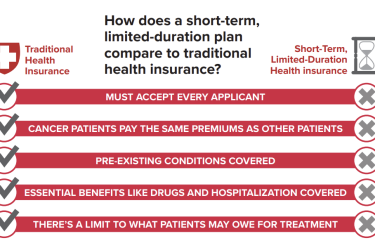The Affordable Care Act last week survived yet another near-death experience – but the story isn’t over.
What’s next, though, is not yet clear. Here are a few possibilities, with the caveat that so much is in flux anything can happen:
Back to the drawing board
President Trump all weekend kept tweeting that Congress shouldn’t give up, even hinting that he would take legislator’s health care benefits away if they don’t deliver.
If ObamaCare is hurting people, & it is, why shouldn’t it hurt the insurance companies & why should Congress not be paying what public pays?
— Donald J. Trump (@realDonaldTrump) July 31, 2017
His budget chief said the Senate should not take up any other business until it finishes the repeal job. However, right now, the Senate does not have the votes for repeal, be it comprehensive or “skinny.” Nor does the Senate want to accept the House-passed repeal-and-replace legislation as is.
Encourage implosion
If Congress does not move ahead, the White House could cut off cost-sharing reduction payments, as Trump has threatened to on and off for months. That would mean that insurers would either leave the markets for 2018 or raise premiums even more to cover those costs since they have to keep paying according to the law, even if government doesn’t reimburse them.
Trump maintains that if the ACA implodes, Democrats will be ready to deal. But his advisers aren’t so sure about that and have been recommending caution. There’s been a bit of talk in Congress about appropriating the money for these subsidies – but no action, and with the House on its break, nothing can be done legislatively in time for the next scheduled payment in late August. (The issue also is pending in court.)
Continue undermining the ACA
There are many ways HHS and CMS can undermine the law without outright repealing it. Sec. Tom Price said on “Meet the Press” after the collapse of the Senate bill that he’ll follow the law of the land. But that doesn’t mean he has to make it work as well as it possibly could. The administration already has cut outreach and positive messaging about enrollment – it also could stop enforcing the individual mandate, even if it stays on the books.
State-centered solution
There are at least two proposals – one from Sens. Bill Cassidy and Lindsey Graham and another by Cassidy and Sen. Susan Collins – that basically would take most of the money that goes toward implementing the federal law and give it to the states to figure out. That hasn’t picked up traction, but it could – maybe – now.
A stabilization bill
This would shore up the ACA markets, but almost certainly would require bipartisanship. Medicaid expansion would continue. It would probably include the cost-sharing reduction subsidies and some other risk-mitigation payments to insurers. (Here are stories about this by Drew Altman and Larry Levitt of the Kaiser Family Foundation and Noam Levey of the Los Angeles Times.)
John McCain’s “no” vote was meant to force – or at least strongly encourage – a bipartisan approach. Maybe Congress will get there, but not today, not after more than seven years of rancor.








